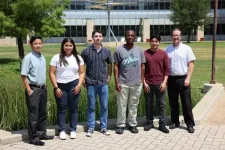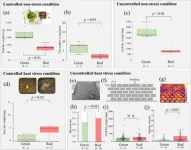(Press-News.org) Four senior bioengineering students at The University of Texas at Arlington have won the Biomedical Engineering Society (BMES) Coulter College for Healthcare Innovation competition for their work on an early detection device for atrial fibrillation.
Brady Killham, Juan Ramirez, Jeannette Santos and Michael Ikefuna, all seniors in UTA’s Bioengineering Department, earned the Best Overall award for their plan to develop FibGuard, a wearable, non-invasive atrial fibrillation early detection device.
UTA competed against teams from Vanderbilt, Purdue, Virginia Tech, Wake Forest, Texas A&M, the University of Oklahoma and Rensselaer Polytechnic Institute, among others. Previous winners include teams from Massachusetts Institute of Technology, the University of Florida, and Boston University. BMES hosted the competition, in partnership with Medtronic and The Wallace H. Coulter Foundation, so students could learn and engage with professionals, expand their networks and foster collaborations with fellow students who share similar interests.
“This is an outstanding result from our team, and we are proud of these students for their performance and their ability to learn and adjust during the competition,” said Michael Cho, chair of the Bioengineering Department. “Their experiences in the clinical immersion program really helped them succeed.”
Twelve universities are selected each year to take part in the competition. The UTA team, along with faculty advisors Jun Liao and Justyn Jaworski, also presented their winning project at the BMES annual conference in October.
Liao and Jaworski, a professor and assistant professor of bioengineering, respectively, picked the team members from the department’s National Institutes of Health-funded clinical immersion program, where students participate in summer clinical experiences at organizations such as UT Southwestern, Arlington EMS, Texas Health Resources and Arlington Memorial Hospital.
The goal of the competition is to gain a better understanding of the importance and quality of medical devices and the needs of patients and clinicians. During the three-day event, teams had access to mentors in the biomedical engineering field and from the business world. The mentors weighed in on teams’ ideas and gave feedback to help them fine-tune their product and presentation.
“We received a background assignment to become familiar with the needs in the area and then interviewed clinicians, such as Dr. Matthias Peltz at UT Southwestern, about what devices already exist, the market and the stockholders,” Killham said.
“The business side was the hardest because none of us had a business background,” Ikefuna said. “We were lucky to have this experience, and we learned quickly. The greatest takeaway was networking with real businesspeople from companies and startups.”
The UTA team developed novel enhancements to medical devices such as masks associated with the treatment of sleep apnea. These enhancements allow for early detection of atrial fibrillation in this high-risk patient population.
“We had ideas based on existing devices, but when we presented them to the mentors, they weren’t really into them,” Santos said. “We had to go back to the drawing board to find something unique, and that’s when we chose to focus on sleep apnea.”
The mentors were a valuable resource throughout the competition, according to Ramirez.
“There were a lot of components to this competition from design and business perspectives,” he said. “Telling us that our original idea wasn’t good really helped us because we found something that separated us from our competition. Once we found that subset, things really fell into place, and our mentors started getting more and more excited.”
Written by Jeremy Agor, College of Engineering
END
Bioengineering team wins health care innovation competition
Senior bioengineering majors take home award for work on atrial fibrillation device
2023-10-20
ELSE PRESS RELEASES FROM THIS DATE:
Antimicrobial peptides modulate lung injury by altering the intestinal microbiota
2023-10-20
BIRMINGHAM, Ala. – Lung development in the fetus occurs at low oxygen tension in the womb, but after a very premature birth, the partly developed lungs of the tiny infants experience far greater oxygen tensions even without the prolonged supplemental oxygen that is often required. This can produce well-known disastrous effects on the structure and function of the neonatal lung, causing the serious lung condition of bronchopulmonary dysplasia in high-risk premature infants.
Using a neonatal mouse model, researchers ...
Diagnosis and management of postoperative wound infections in the head and neck region
2023-10-20
“The majority of wound infections often manifest themselves immediately postoperatively, so close followup should take place [...]”
BUFFALO, NY- October 20, 2023 – A new research perspective was published in Oncoscience (Volume 10) on October 4, 2023, entitled, “Diagnosis and management of postoperative wound infections in the head and neck region.”
In everyday clinical practice at a department for oral and maxillofacial surgery, a large number of surgical procedures in the head and neck region take place under both outpatient and inpatient conditions. The basis ...
Brain & Behavior Research Foundation awards $10.2 million in Young Investigator Grants to 150 mental health scientists
2023-10-20
The Brain & Behavior Research Foundation announced it is awarding $10.2 million in Young Investigator Grants to 150 promising early career scientists who are working to identify causes, improve treatments, and develop methods of prevention for psychiatric illnesses that impact millions of people in the United States and around the world.
The 2023 Young Investigators are focused on a broad range of psychiatric illnesses. More than half of the projects are relevant to the study or treatment of depression and schizophrenia. Addiction/substance-use disorders, anxiety, and ...
Contaminants in cannabis and hemp flowers create potential for health risks
2023-10-20
Cannabis use, even for medical purposes, could make some people sick due to harmful fungi that contaminate the plants.
That is the finding of a recently published peer-reviewed journal article, whose authors recommend further study and consideration of changes to regulations to protect consumers, especially those who are immunocompromised. They examined data, previous studies, and U.S. and international regulations related to the cannabis and hemp industry.
The article was published in Frontiers in Microbiology. It was researched and written by Kimberly Gwinn, professor of entomology and plant pathology at the University of Tennessee Institute ...
COVID-19-related jail decarceration did not affect crime in California
2023-10-20
Since 2011, California has significantly reformed its criminal justice system, reducing the size of its prison population, with no effect on violent crime and only marginal impacts on property crime statewide. The COVID-19 pandemic furthered decarceration as the state reduced state prison and jail populations to slow the spread of the virus. Concerns emerged that releases under the auspices of COVID mitigation harmed public safety. A new study explored this notion and found no consistent relation between COVID-19-related jail decarceration and violent or property ...
Challenging prehistoric gender roles: Research finds that women were hunters, too
2023-10-20
It’s a familiar story to many of us: In prehistoric times, men were hunters and women were gatherers. Women were not physically capable of hunting because their anatomy was different from men. And because men were hunters, they drove human evolution.
But that story’s not true, according to research by University of Delaware anthropology professor Sarah Lacy, which was recently published in Scientific American and in two papers in the journal American Anthropologist.
Lacy and her colleague Cara Ocobock from the University of Notre Dame examined the division of labor according to sex during the Paleolithic era, approximately 2.5 million to 12,000 ...
Felix Parra Diaz elected a fellow of the American Physical Society
2023-10-20
Felix Parra Diaz, the head of the Theory Department at the U.S. Department of Energy’s (DOE) Princeton Plasma Physics Laboratory (PPPL), has been elected a 2023 Fellow of the American Physical Society (APS). This honor recognizes scientists who have helped advance physics by contributing original research, showing how to apply physics to the worlds of science and technology, or exhibiting excellence in physics teaching.
Parra Diaz was cited for “transformational contributions to the theory ...
ESMO Manifesto - Translating scientific evidence into effective public health policy
2023-10-20
ESMO announces Public Policy Manifesto on key issues for oncology to bring to European institutions after 2024 elections.
Studies presented at the ESMO Congress 2023 set new standards of care across a wide range of tumour types.
Madrid, Spain, 20 October 2023 – Evidence is building up that strong political action has the potential to tackle two of our era’s biggest challenges: climate change and the increasing burden of cancer on society. At the opening press conference of the ESMO Congress 2023 taking place 20-24 October in Madrid, Spain, a slew of studies marking meaningful ...
Massachusetts Life Sciences Center awards $4.3 million to MBL to support imaging innovation
2023-10-20
WOODS HOLE, Mass.—The Massachusetts Life Sciences Center (MLSC) has awarded $4.3 million to the Marine Biological Laboratory (MBL) to expand its imaging capabilities to serve the Massachusetts life sciences community.
The grant, which will be used to procure two state-of-the art microscopes capable of increased resolution and advanced technology, such as milling for the reconstruction of samples in 3D, was announced at a press conference on October 18 at the grand opening of a new incubator, the Massachusetts Biomedical Initiatives (MBI).
MBL Director of Research Anne Sylvester ...
Does urbanization trigger plant evolution?
2023-10-20
Urbanization and human activities have transformed a significant proportion of the land on Earth, resulting in the formation of urban environments. These urban environments are man-made habitats that often impose several selective pressures on their inhabitants. A key characteristic of such environments is the presence of impermeable, heat-retaining surfaces created using brick, stone, asphalt, and concrete. Notably, these surfaces form urban heat islands, i.e., regions with elevated surface temperatures. An unexpected result of heat stress ...
LAST 30 PRESS RELEASES:
Anthropologists offer new evidence of bipedalism in long-debated fossil discovery
Safer receipt paper from wood
Dosage-sensitive genes suggest no whole-genome duplications in ancestral angiosperm
First ancient human herpesvirus genomes document their deep history with humans
Why Some Bacteria Survive Antibiotics and How to Stop Them - New study reveals that bacteria can survive antibiotic treatment through two fundamentally different “shutdown modes”
UCLA study links scar healing to dangerous placenta condition
CHANGE-seq-BE finds off-target changes in the genome from base editors
The Journal of Nuclear Medicine Ahead-of-Print Tip Sheet: January 2, 2026
Delayed or absent first dose of measles, mumps, and rubella vaccination
Trends in US preterm birth rates by household income and race and ethnicity
Study identifies potential biomarker linked to progression and brain inflammation in multiple sclerosis
Many mothers in Norway do not show up for postnatal check-ups
Researchers want to find out why quick clay is so unstable
Superradiant spins show teamwork at the quantum scale
Cleveland Clinic Research links tumor bacteria to immunotherapy resistance in head and neck cancer
First Editorial of 2026: Resisting AI slop
Joint ground- and space-based observations reveal Saturn-mass rogue planet
Inheritable genetic variant offers protection against blood cancer risk and progression
Pigs settled Pacific islands alongside early human voyagers
A Coral reef’s daily pulse reshapes microbes in surrounding waters
EAST Tokamak experiments exceed plasma density limit, offering new approach to fusion ignition
Groundbreaking discovery reveals Africa’s oldest cremation pyre and complex ritual practices
First breathing ‘lung-on-chip’ developed using genetically identical cells
How people moved pigs across the Pacific
Interaction of climate change and human activity and its impact on plant diversity in Qinghai-Tibet plateau
From addressing uncertainty to national strategy: an interpretation of Professor Lim Siong Guan’s views
Clinical trials on AI language model use in digestive healthcare
Scientists improve robotic visual–inertial trajectory localization accuracy using cross-modal interaction and selection techniques
Correlation between cancer cachexia and immune-related adverse events in HCC
Human adipose tissue: a new source for functional organoids
[Press-News.org] Bioengineering team wins health care innovation competitionSenior bioengineering majors take home award for work on atrial fibrillation device






